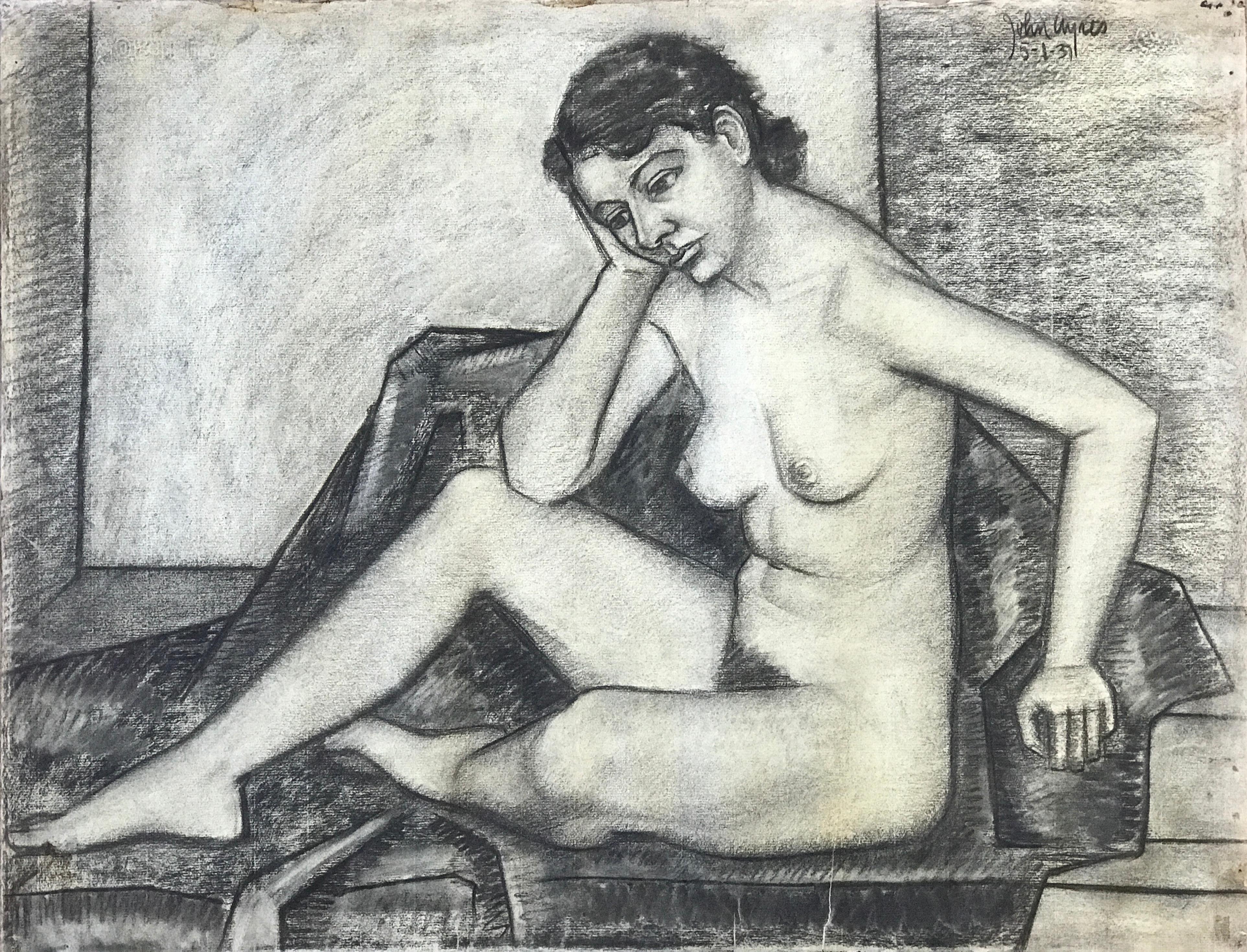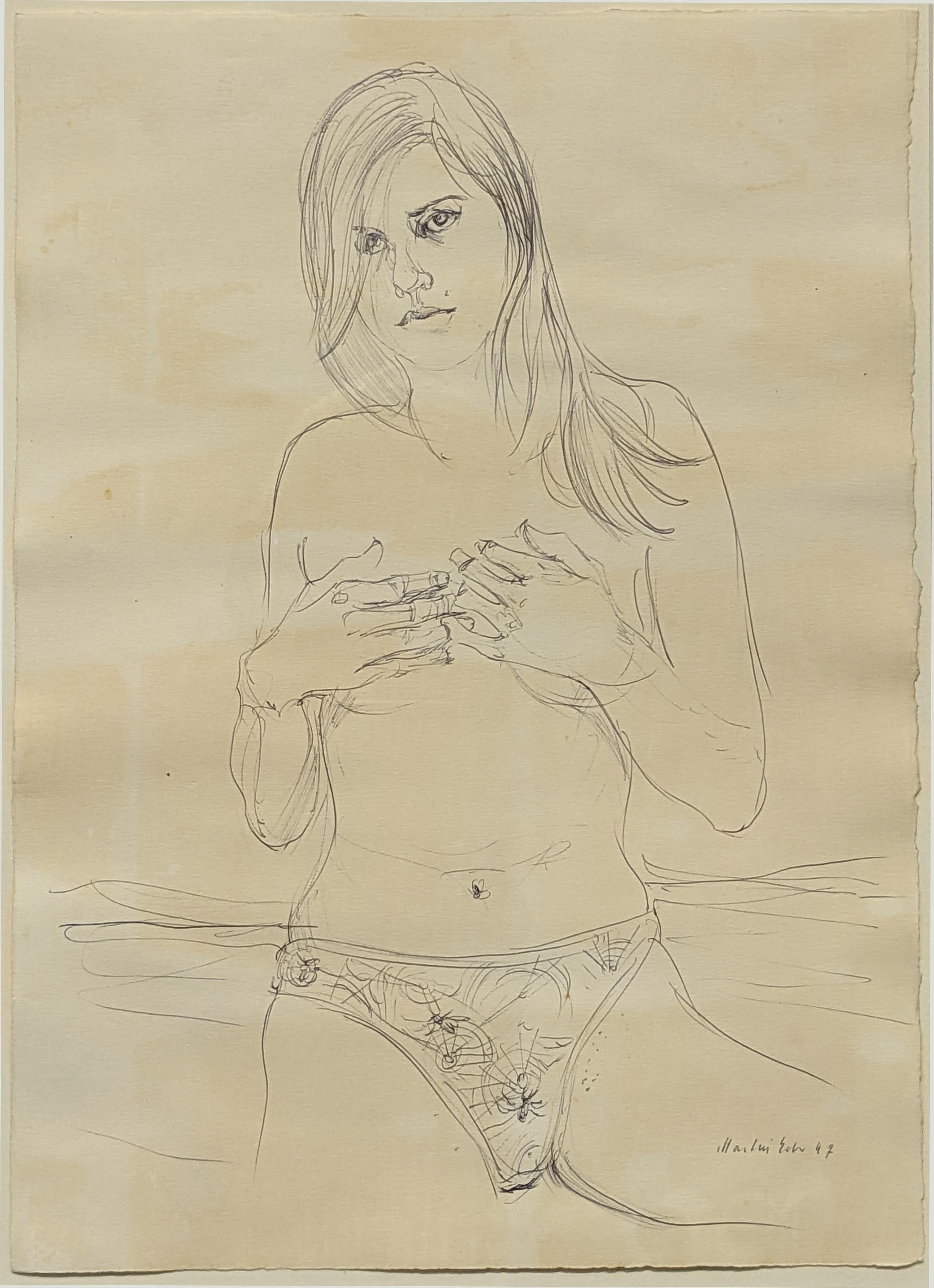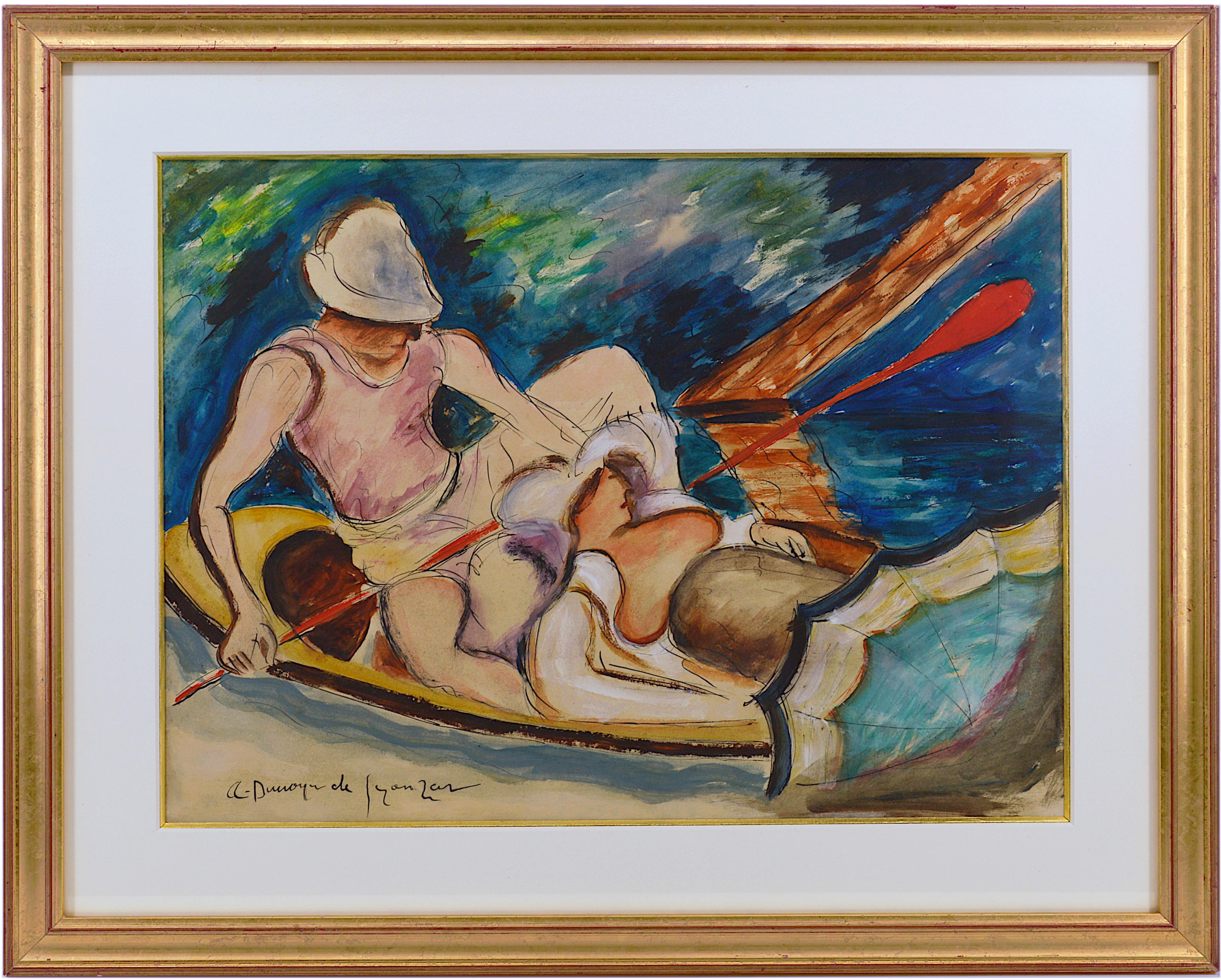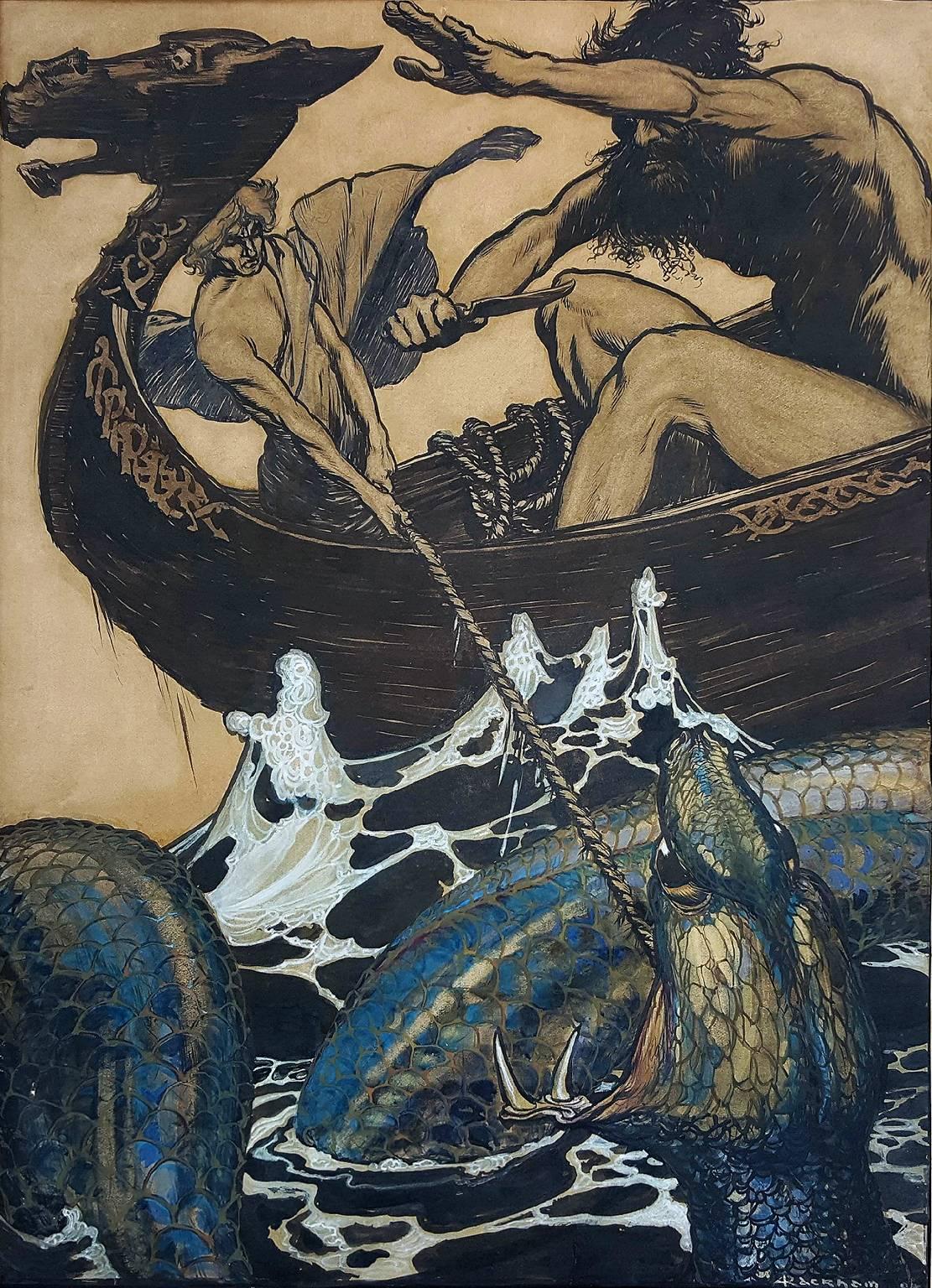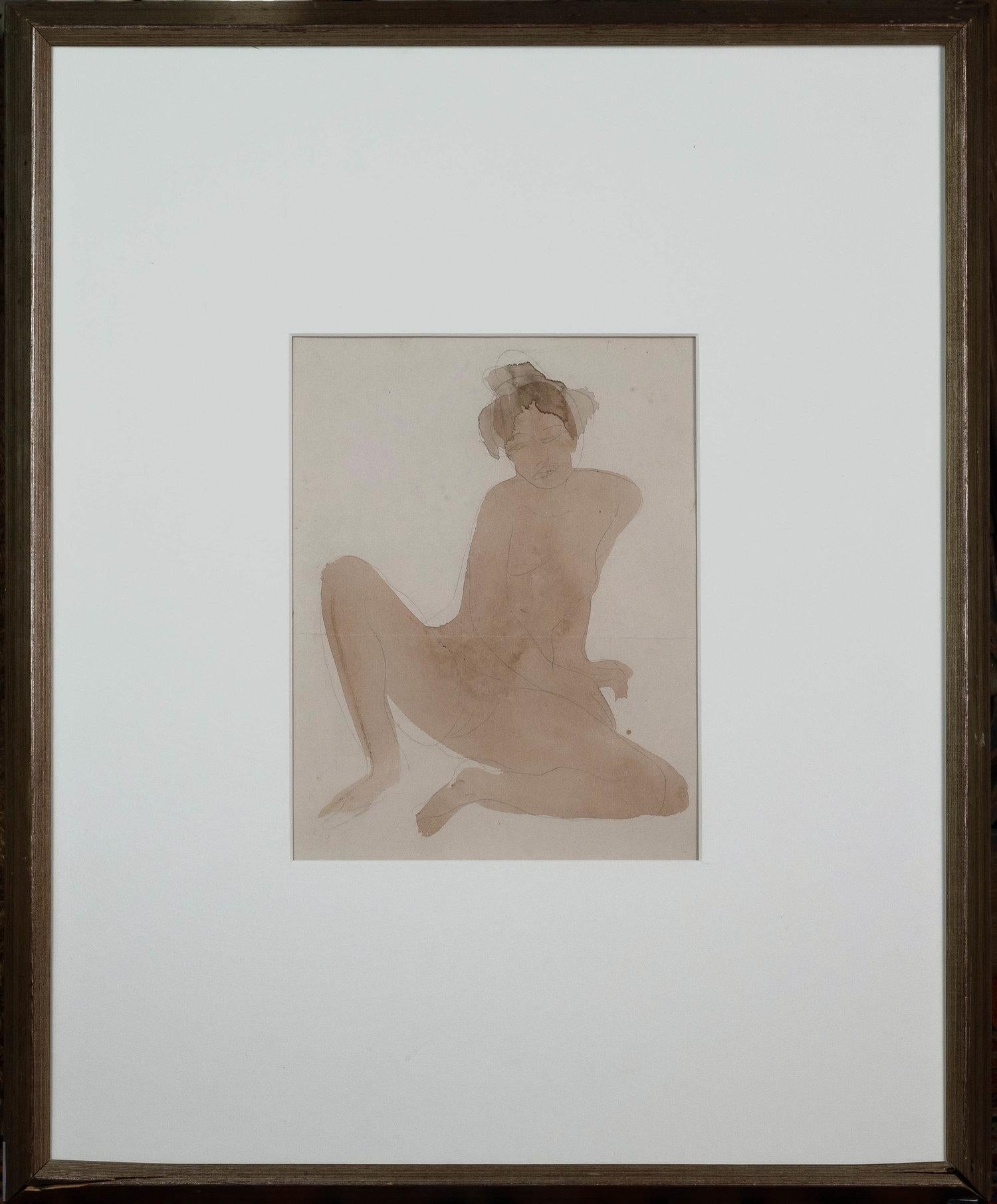Items Similar to Water Sports - Nude Swimmers and Bathers at Coney Island
Want more images or videos?
Request additional images or videos from the seller
1 of 15
Reginald MarshWater Sports - Nude Swimmers and Bathers at Coney Island1944
1944
About the Item
Historically, academic artists have always featured the central figures in their composition in a prominent light with the background figures being darker. In water sports, Reginald Marsh does the opposite. The central figures are in shadow and the role players in the background are in the light. This aesthetic choise by Marsh makes "Water Sports" a more interesting and unique artwork. Sexy bodies from the '40s in bathing suits at the beach at Coney Island. Five sexy women riding on the shoulders of men and having a great time of fun and folic. Presented in a good broad craved and antiqued giltwood frame in the Spanish Baroque style. Each corner boldly carved with a stylized anthemion mantled by foliate scrolls.
Bernard Danenberg Galleries, New York
Galleries Maurice Sternberg, Chicago.
Born in Paris, Reginald Marsh was an American artist recognized for his Social Realist paintings of New York City life in the 1920s and ‘30s. Rejecting abstraction, Marsh included crowded Coney Island beach scenes, vaudeville and burlesque shows, women, and jobless men on the Bowery among his favorite subjects. Marsh was a prolific drawer as well, filling books with sketches made on streets, beaches, and public transportation. He painted in egg tempera, oils, watercolors, and ink, and produced many prints as well.
- Creator:Reginald Marsh (1898-1954, American)
- Creation Year:1944
- Dimensions:Height: 26.5 in (67.31 cm)Width: 39.5 in (100.33 cm)
- Medium:
- Movement & Style:
- Period:
- Condition:
- Gallery Location:Miami, FL
- Reference Number:1stDibs: LU38538512732
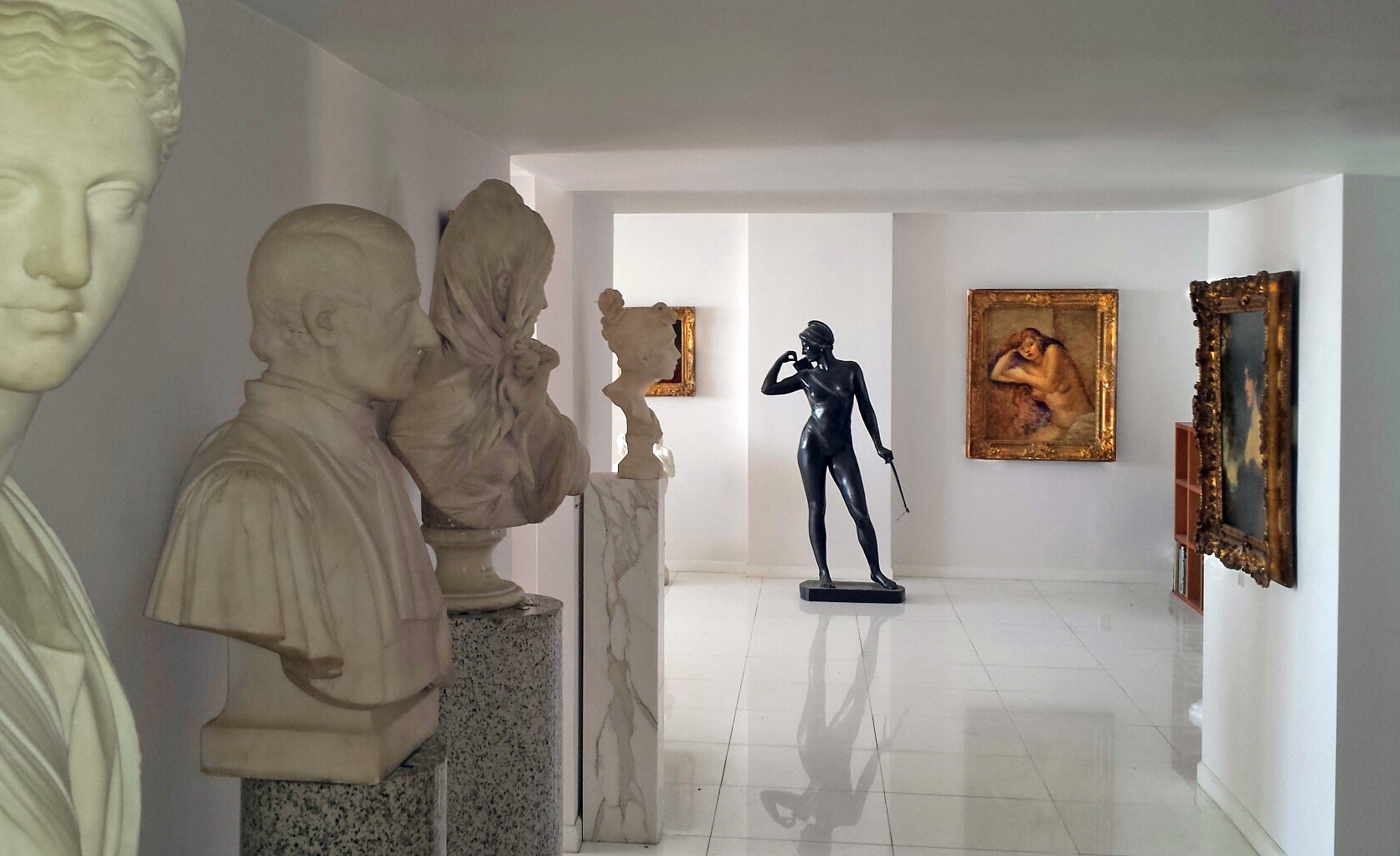
About the Seller
4.9
Gold Seller
These expertly vetted sellers are highly rated and consistently exceed customer expectations.
Established in 2005
1stDibs seller since 2016
102 sales on 1stDibs
Typical response time: 1 hour
- ShippingRetrieving quote...Ships From: Miami, FL
- Return PolicyA return for this item may be initiated within 3 days of delivery.
More From This SellerView All
- Sea Battle - (Stories from the Edda)By Arthur RackhamLocated in Miami, FLSigned, "A Rackham" lower right Sotheby's New York Arthur Rackham is widely regarded as one of the leading illustrators from the 'Golden Age' of British book illustration Rackham...Category
Early 1900s Impressionist Figurative Drawings and Watercolors
MaterialsIndia Ink, Watercolor, Gouache
- Heads in Profile- Women IllustratorsBy Barbara NessimLocated in Miami, FLBarbara Nessim is an artist/ illustrator who has contributed to Harper's Bazaar, Esquire, New York Magazine, Rolling Stone, Time, Ms among others. Sign...Category
1990s Modern Figurative Drawings and Watercolors
MaterialsWatercolor, Ink
- Swimmers and Divers - Women IllustratorsBy Barbara NessimLocated in Miami, FLBarbara Nessim is an artist/ illustrator who has contributed to Harper's Bazaar, Esquire, New York Magazine, Rolling Stone, Time, Ms among others. She ...Category
1990s Contemporary Figurative Drawings and Watercolors
MaterialsWatercolor, Ink
- Pondering being Naked - Sexy Girl taking off Bikini - Female CartoonistLocated in Miami, FLThis work clearly has homosexual overtones which in the mid-'40s was as daring as showing nudity. I am not sure if this was the artist's intention but the salesgirl and the model look identical and she signs it twice Shermond. Added to this is a strobe light effect where the model's image is partly replicated giving the impression of 2 figures. She's lost in thought pondering the notion of removing the bows and seeing the consequences. Meanwhile, the sales girls ( perhaps her alta ego - perhaps an admirer ) eggs her on. Caption: "You can always remove the bows if you think they're too fussy." Cover cartoon for unknown publication - Signed "Shermund" twice in the lower right image, dated on verso, and captioned in graphite in the lower margin. Original Matte and not framed - Barbara Shermund...Category
1940s Feminist Figurative Drawings and Watercolors
MaterialsInk, Watercolor, Graphite
- Seductive Platinum Blond Hair and Blue Eyed Pin Up in Turquoise HatBy Alberto VargasLocated in Miami, FLStudy of a sultry and seductive reclining platinum blond Pin Up with a wide-brimmed sun hat. Most likely done for Playboy. This work is very finely rendered and looks better the ...Category
1960s American Realist Figurative Drawings and Watercolors
MaterialsWatercolor, Pencil
- Sitting Nude exudes sexualityBy Gaston LachaiseLocated in Miami, FLThe key element to this work is that it is much larger that most of the other works on paper by Lachaise and somewhat more delineated and refined . The figure exudes sexuality has a...Category
1920s American Realist Nude Drawings and Watercolors
MaterialsPencil
You May Also Like
- 1937 Academic Female Nude Charcoal Drawing "Head in Hand" UC BerkeleyBy John AyresLocated in Arp, TXJohn Ayres Head in Hand May 1, 1937 Charcoal on Paper 25"x19", unframed $1250 Signed and dated in charcoal top right *Custom framing available for additional charge. Please expect fr...Category
1930s Realist Figurative Drawings and Watercolors
MaterialsCharcoal, Paper, India Ink
- untitled / ohne TitelBy Martin EderLocated in New York, NYMartin Eder untitled work on paper executed in ballpoint pen with traces of watercolor. Ohne Titel Arbeit auf Papier, ausgeführt in Kugelschreiber mit Spuren von Aquarell. 2007Category
Early 2000s Realist Nude Drawings and Watercolors
MaterialsInk, Watercolor, Pen
- "Boating on the Morin River"By André Dunoyer de SegonzacLocated in Saint Amans des cots, FRPen, ink, watercolor and wash on paper by André Dunoyer de Segonzac, France, 1922-1924. Boating on the Morin River. Measurements : with frame: 52.5x65x2 cm - 20.7x25.6x0.8 inches / without frame: 36.5x45 cm - 14.4x17.7 inches. Signed lower left "A. Dunoyer de Segonzac". Colors may vary slightly depending on your screen. The lighter band at the top and the bottom of the piece, visible in the first picture, is only due to the reflection in the protective glass. It does not exist. In its frame gilt with gold leaf and its protective glass. André Dunoyer de Segonzac was born in Boussy-Saint-Antoine (Essonne) July 7, 1884. After his schooling at high school Henri IV, as early as 1900, he attends classes at the National School of Fine Arts in Paris in free listener where he will befriend Charles Dufresne. In 1903, he enters the private studio of Luc-Olivier Merson. In 1907, he studies with Jean-Paul Laurens and attends the La Palette and Colarossi academies in Montparnasse. He meets Luc-Albert Moreau and Jean-Louis Boussingault with whom he shares a studio. His first drawings are published in 1908 in The Great Review and The Witness. Nearly indifferent to contemporary aesthetic revolutions, Dunoyer de Segonzac undertakes, with Jean-Louis Boussingault and Luc-Albert Moreau, to revive Gustave Courbet's realism by performing still lifes, nudes, landscapes, in a thick paste and masonry . In one of his letters to the painter Maurice Boitel, he wrote in the 1950s: "I have not forgotten the heroic period of the independents - when we were grouped around Paul Signac, the charming and valiant Maximilien Luce - in these barracks where the living and authentic Art was grouped outside the academic formulas - or literary and systematic tendencies - which were to lead to this abstract aesthetic of which the painting dies. " In 1908, he begins exhibiting at the Salon d'Automne and the Salon des Indépendants, with Paul Signac and Maximilien Luce. He befriends Apollinaire, Max Jacob, Raoul Dufy and Vlaminck. From this period, renting a house belonging to Signac, Dunoyer discovers the landscapes of Saint-Tropez, to which he will remain faithful and where he lived until the end of his life. He stays in Saint-Tropez only in the summer season. For the rest, he leads a real nomadic life, in search of the motive especially through the Île-de-France, the Grand Morin valley, Feucherolles, Chennevières-sur-Marne, Guyancourt, etc. "I also worked a lot on the banks of the Seine in Chatou, Bougival, Andrésy, Poissy and Triel that I particularly like, with its beautiful Gothic church that is reflected in the Seine and the high wooded hills that surround him", he will say. In 1910, he knows fashion designer Paul Poiret and meets Max Jacob, Raoul Dufy and Vlaminck. From 1910 to 1914, he travels to Italy, Spain, North Africa, and is interested in sport and dance (drawings of Isadora Duncan's Russian Ballets, 1911, The Boxers1910). From 1914 to 1918, mobilized in the infantry, he makes the war hardly, before being assigned to camouflage. He performs many war drawings, valuable for their artistic and documentary value. From 1919, he appears again in many exhibitions, including major Parisian salons. Nearly indifferent to contemporary aesthetic revolutions, Dunoyer de Segonzac undertakes, with Boussingault and Moreau, to revive Courbet's realism by performing still lifes, nudes, landscapes, in a thick and masonry paste. Enlisted in engraving by Jean Émile Laboureur, he makes nearly 1,600 brass plaques from 1919 to 1970. He was president of the Society of French painters-engravers. In 1921, he meets Paul Valéry, Léon-Paul Fargue and Jean Cocteau. In 1928, he makes a trip to America where he met with great success. In 1930, he becomes friend with Derain. In 1933 he receiveds the Carnegie Foundation of Pittsburgh Award and in 1934 the Venice Biennale. During the Occupation, in November 1941, he takes part in a "study trip" to Germany, organized by Arno Breker, accepting, like other artists of the most renowned, to visit the hotspots of German culture as well as artist workshops. After the war, he is exhibited in the best galleries...Category
1920s Realist Figurative Drawings and Watercolors
MaterialsPaper, Ink, Watercolor, Pen
- Rare Rodin Watercolour & Pencil on Paper of a Seated Nude - The Cambodian DancerBy Auguste RodinLocated in London, GBAuguste RODIN (1840-1917) Seated Nude, Cambodian Dancer c. 1898 - 1900 Pencil and watercolour 11.5 x 9.3 inches; 25 x 20.5 inches, inc. frame Provenance: Christie's South Kensington: Wednesday, November 28, 2007 "It's very simple. My drawings are the key of my art." Rodin was an extraordinary creative artist and a prolific worker. After attending the “Petite École”, he worked in the studio of the ornamentalist Albert-Ernest Carrier-Belleuse, first in Paris, then in Brussels, where his skill in handling decorative subjects fashionable in the 18th century became apparent. His discovery of Michelangelo, during a visit to Italy in 1875-76, was a decisive moment in his career. Rodin would, in turn, break new ground in sculpture, paving the way for 20th-century art, by introducing methods and techniques that were central to his own artistic aesthetics. In 1906, King Sisowath of Cambodia visited France on an official state visit. It was on this visit that Rodin discovered the dancers of the Cambodian Royal Ballet and was inspired to draw and paint them over 150 times. They made a deep impression on the artist, as he confided to Georges Bourdon, in an article for the newspaper Le Figaro on 1 August 1906: “There is an extraordinary beauty, a perfect beauty, about these slow, monotonous dances, which follow the pulsating rhythm of the music… [The Cambodians] have taught me movements I had never come across anywhere before…” Originally seeing them in Paris he left everything suddenly to follow the dancers of the royal ballet to Marseille, from where they would embark on their return to Cambodia. In just one week, he made about one hundred and fifty drawings, re-transcribing or interpreting the ballet poses, with an obvious fascination for the arms and hands of the dancers. These drawings were later highlighted with watercolour, creating coloured harmonies of a rare refinement. The first performance of the Cambodian Royal Ballet took place in the context of the Colonial Exhibition in Marseille. Sisowath 1st had just been crowned King of Cambodia when he undertook the first trip ever to be made by a Cambodian sovereign to France, which had controlled Cambodia since June 1884. This official visit occurred at the height of French colonial expansion. Previously, the Universal Exhibition of 1900 had attracted 48 million visitors! The organisers realised what a tremendous impact this event made on the public, and it was soon adopted as the main tool for colonial propaganda. At the exhibition in Marseilles, the area devoted to Indochina was the largest of the seven sections. When Auguste Rodin met the troupe of dancers for the first time in July 1906, during their brief visit to Paris for an exceptional performance at the Pré Catalan...Category
19th Century Realist Figurative Drawings and Watercolors
MaterialsWatercolor
- BallerinaBy Charles KifferLocated in San Francisco, CAThis artwork titled "Ballerina" c.1950 is a watercolor on paper by French noted artist Charles Kiffer, 1902-1992. It has the estate stamp of the artist on the back. The artwork size ...Category
Mid-20th Century Realist Figurative Drawings and Watercolors
MaterialsWatercolor
- "The Dance, " Ludovico Lipparini, graphite, gouache, mythological, classicalLocated in Wiscasset, ME"The Dance" by Ludovico Lipparini is a beautifully rendered work on paper in the classical tradition using graphite and gouache and created in the f...Category
Early 19th Century Realist Figurative Drawings and Watercolors
MaterialsGraphite, Paper, Gouache
